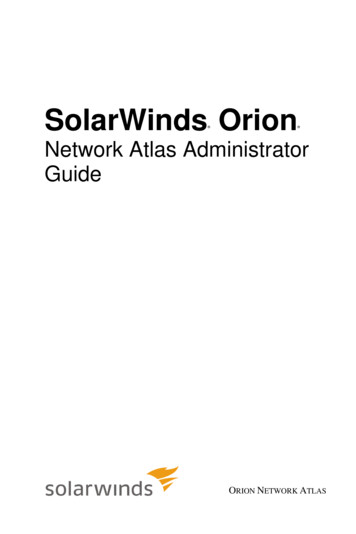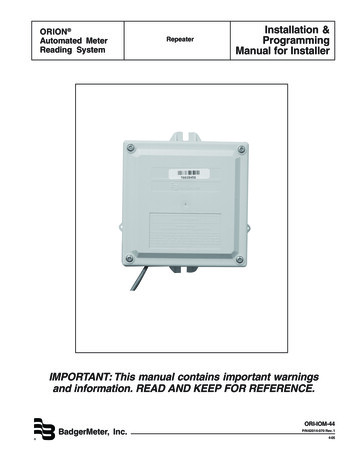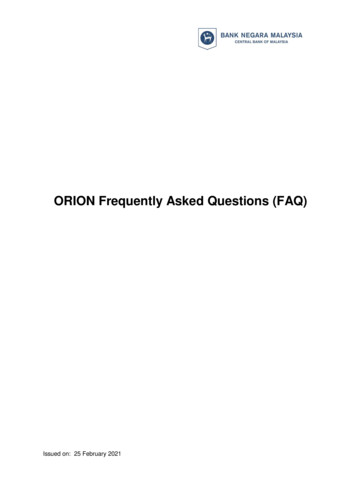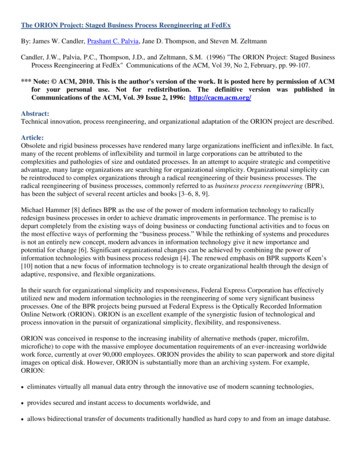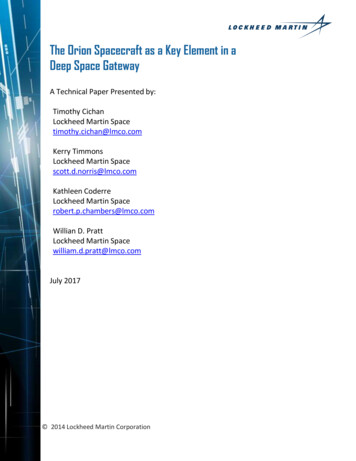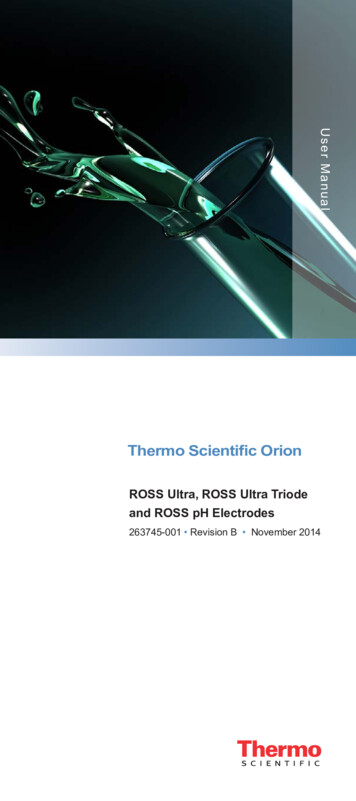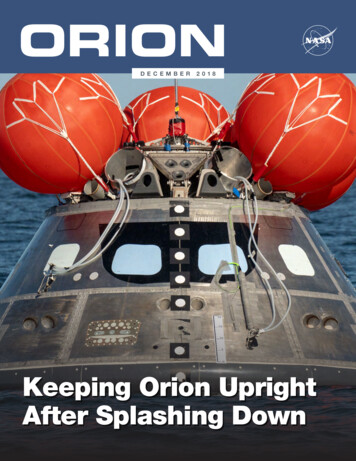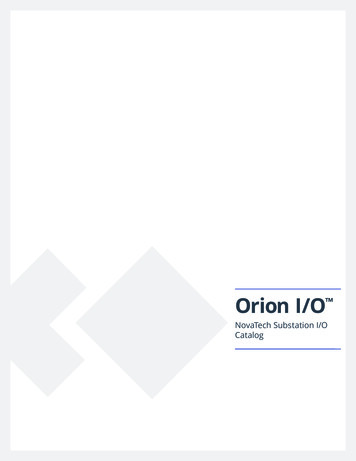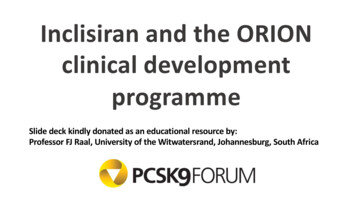
Transcription
Inclisiran and the ORIONclinical developmentprogrammeSlide deck kindly donated as an educational resource by:Professor FJ Raal, University of the Witwatersrand, Johannesburg, South Africa
Inclisiran and the ORION ProjectDerick RaalFCP(SA), FRCP, FRCPC, Cert Endo, MMED, PHDHead, Division of Endocrinology & MetabolismDirector, Carbohydrate and Lipid Metabolism Research UnitFaculty of Health Sciences, University of the Witwatersrand
Catabolism of LDL, the role of PCSK9antibody to PCSK9LDL receptorLDLmAbEndocytosisRecycling /exportsiRNAor ASOmodified from Hovingh G K, et al. Eur Heart J asmicreticulumNucleus SREBPHepatocyteLysosomem o d ifie d fro m H o vin g h G K , e t a l. E u r H e a rt J 2 0 1 3 ;3 4 :9 6 2 -7 1
Pharmacokinetics of PCSK9 monoclonal antibody therapy160Total AMG 145 (evolocumab)450Free 000142842Study DayStein EA & Raal FJ Annu. Rev. Med. 2014. 65:417–31.567084LDL-C M ean Change (%)Free PCSK9 concentration (ng/mL)Free evolocumab concentration (ng/mL x 0.01)500
Reduction in LDL-C values among healthyvolunteers in single-dose studiesSubcutaneous administration of AlirocumabMean change from baseline in LDL-C (%)20Placebo50 mg100 mg150 mg250 mg100-10-20-30-40-50-60-701 2 4 811152229438485106Study DayStein E. N Engl J Med 2012;366:1108-18S te in E . N E n g l J M e d 2 0 1 2 ;3 6 6 :1 1 0 8 -1 8
Model predicted time course of LDL-C aftermultiple evolocumab dosesLDL-C (% change from baseline)0280 mg QM420 mg QM140 mg Q2W-20-40-60-800246Tim e (weeks)Gibbs et al. J Clin Pharm. 2017;57:61681012
Unmet needLDL-C variability common, associated with worse outcomesSix month percent change in LDL-Camong statin users from starting level1Increase in death, CV outcomes witheach 1 standard deviation of LDL-C variability 26023%% change in LDL-C from BL4017%2016%11%010%-2 0-4 0De a th-6 01.2.7Ray KK et al. N Engl J Med 2017; 376:1430-1440Bangalore S et al. JACC 2015; 65: 1539-1548Stro k eAn yc o ro na rye v en tAn y CVe v en tMI
Small interfering RNA (siRNA) targeted to PCSK9Mechanism of actionRISC RNA induced silencing complexWhitehead et al. Nat Rev Drug Discov 2009;8:129-38
GalNAc-siRNA conjugates facilitate rapid hepatic uptakeBackgroundInclisiran:siRNA conjugated toN-acetylgalactosamineSubcutaneous administrationTargeted deliveryto hepatocytesThird generation with enhancedstablilisation chemistryAsialoglycoprotein receptor(ASGPR):Highly expressedin hepatocytes only.High rate of uptake
Clinical & regulatorystrategyORION ProgramStudy Rationale and Designs10
ORION clinical development program overviewClinical & regulatorystrategyASCVD or ASCVD risk equivalentsTotal 18,500ORION-4(15,000 high risk ASCVD)Phase IIIORION-11(1500 ASCVD/RE)Phase IIIHeFH & HoFHORION-2 & -5 (60 HoFH)Phase II & IIIORION-9(400 HeFH)Phase IIIORION-1(500 ASCVD)Phase IIORION-3Phase II extensionORION-10(1500 ASCVD)Phase IIIORION-8Phase III extensionORION-16(40 HeFH peds)Phase IIIORION-19 HoFH (8-11)ORION-20 HeFH (8-11)Special populationsORION-6 & -7renal & hepaticimpaired) PKORION-12 TQT11ORION-13(12 HoFH peds)Phase IIIORION-14 & -15PK/PD Japan &China
ORION development program through ORION-12TrialsRelevant endpointsPatients selected(num ber)ORION-4Cardiovascular M&M (Phase III)HRASCVD or ASCVD RE (N 15,000) Q2 2018ORION-5LDL-C lowering (Phase III)HoFH (N 60)Q2/3 2018ORION-9LDL-C lowering (Phase III)HeFH (N 400)OngoingORION-10 LDL-C lowering (US) (Phase III)ASCVD (N 1,500)OngoingORION-11 LDL-C lowering (EU) (Phase III)ASCVD or ASCVD RE (N 1,500)OngoingORION-3LDL-C lowering(extension of ORION-1)ASCVD or ASCVD RE or HeFH(N 490)OngoingORION-8LDL-C lowering (extension ofORION -9, -10, -11)ASCVD, ASCVD risk equivalent,HeFH (N 3,460)Q4 2019Supportive ORION-1trialsLDL-C lowering (Phase II)ASCVD or ASCVD RE or HeFH(N 501)CompletedORION-2LDL-C lowering (Phase II)HoFH (N 10)OngoingPharmacokineticsHepatic impairment (N 24-32)Q2 2018PharmacokineticsRenal impairment (N 31)OngoingHealthy volunteers (N 200)Q1/2 2018Clinical & ialORION-6populationsORION-7studiesORION-12 TQT12Expectedstart tim e
ORION-1Long-Term Efficacy & Safety13
MethodsTrial designScreening (Day -14 to Day -1)Randomization (Day 1, n 501)One dose starting regimenPlacebo 200 mgN 65Day 1Day 14Day 30N 60300 mgN 61500 mgN 65Randomized (n 501)Treated (n 497)Study drug given1 st follow-up visitMonthly follow-up visitsDay 9014Day 180Prim ary evaluationDay 210End of study visitDay 360Extended follow-upCompleted (n 483)Two dose starting regimenPlacebo 100 mgN 62N 61200 mgN 62300 mgN 61Day 1Day 14Day 30Study drug given1 st follow-up visitMonthly follow-up visitsDay 90Study drug givenDay 180Prim ary evaluationDay 210End of study visitDay 360Extended follow-up
Efficacy: One dose starting regimenClamped PCSK9 knockdownMean percent change ( 95% CI)End of study if LDL-Cback to baseline20Placebo0-2 0300 mg-4 0500 mg-6 0-8 0030609012 015 018 0Days from first injection15200 mgP-value for all comparisons to placebo 0.000121 024 027 0
Efficacy: Two dose starting regimenClamped PCSK9 knockdownMean percent change ( 95% CI)End of study if LDL-Cback to baseline20Placebo0-2 0200 mg-4 0300 mg-6 0-8 0030609012 015 018 0Days from first injection16100 mgP-value for all comparisons to placebo 0.000121 024 027 0
Efficacy: One dose starting regimenRobust, sustained LDL-C reductions – 300 mg optimalMean percent change ( 95% CI)300 mg50.9% reduction300 mg38.4% reduction10Placebo0-1 0200 mgP-value for all comparisons to placebo 0.0001-2 0300 mg-3 0500 mg-4 0-5 0-6 0030609012 015 018 0Days from first injection179 months time adjustedmean 41% reduction21 024 027 0
Efficacy: Two dose starting regimenRobust, sustained LDL-C reductions – optimal start regimenMean percent change ( 95% CI)300 mg x255.5%52.6%10Placebo0-1 0100 mgP-value for all comparisons to placebo 0.0001-2 0200 mg-3 0300 mg-4 0-5 0-6 0030609012 015 018 0Days from first injection189 months time adjustedmean 50% reduction21 024 027 0
Efficacy: Two dose starting regimenIndividual patient responses (%) at day 180Change in LDL-C (percent)60Inclisiran 300 mgPercent reduction40200-2 0-4 0Mean 52.6%-6 0-8 0-1 0019PlaceboPercent reductionMax 80.9%All patients responded
Inclisiran dose 300mg sc Day 1, 90, 270 and 6-monthlySustained 50% reduction in LDL-C for 6-months% Change in LDL-C from BaselineOne dose starting regimen (300 mg)1010Time adjusted LDL-Cfor 6 months 41%00-1 0-1 0-2 0-2 0-3 0-3 0-4 0-5 0-6 0Q3-4 0MeanMedianQ1Q3-5 0-6 0Q1-7 0-8 0-8 0Day 270Time adjusted LDL-Cfor 6 months 51%MeanMedian-7 0Day 9020Two dose starting regimen (300 mg)Day 90Day 270
SummaryTwo 300 mg starting dose regimen for inclisiran selectedNo safety concernsOptimal dosage 300 mg giventwice as starting regimen All patients responded withsignificant LDL-C lowering At 6 months, mean LDL-C of52.6% (64 mg/dL), and up to 81%(122 mg/dL)21
The ORION Phase III ProgramORION-2, -3, -5, -7, -9, -10, -1122
ORION: Phase III trialsPivotal Phase III studies to support LDL-C lowering labelingStudySitesMain inclusion criteriaPatientsORION-11EU, SAASCVD (LDL-C 70mg/dL)and risk equivalent patients(LDL-C 100 mg/dL)1,500ORION-10USASCVD (LDL-C 70 mg/dL)1,500ORION-9US, EU, SAHeterozygous FH400ORION-5US, EU, SAHomozygous FH603,460 The Medicines Company 201823
ORION: Phase III trialsDesign of the ORION-9, -10, -11 studiesPatients18 month durationHeFH, ASCVD and/or riskequivalent patientsAge 18 yearsHigh intensity statinLDL-C 70 mg/dL, or 100 mg/dL (RE, HeFH)Inclisiran300 mgRandomize1:1llllllPlacebolVisits The Medicines Company 2018l1m3591115171824
ORION-9, ORION-10 and ORION-11Common inclusion criteriaClinical & regulatorystrategyORION-9ORION-10ORION-11Male or female subjects 18years of ageHistory of HeFH with a diagnosisof HeFH by genetic testing;and/or a documented history ofuntreated LDL-C of 4.9 mmol/L ( 190 mg/dL), anda family history of FH, elevatedcholesterol or early heartdisease may indicate FHMale or female subjects 18years of ageHistory of ASCVD (CHD, CVD orPAD*)Male or female subjects 18years of ageHistory of ASCVD (CHD, CVD orPAD*) or ASCVD-riskequivalents (type 2 diabetes,familial hypercholesterolemia,and including subjects whose10-year risk of a CV eventassessed by Framingham RiskScore or equivalent has a targetLDL C of 2.6 mmol/L ( 100mg/dL).Stable on a low-fat diet(e.g., NCEP)Serum LDL-C 2.6 mmol/L( 100 mg/dL) at screeningN/AN/ASerum LDL-C 1.8 mmol/L( 70 mg/dL) at screeningSerum LDL-C 1.8 mmol/L ( 70mg/dL) for ASCVD subjects or 2.6 mmol/L( 100 mg/dL) for ASCVD-riskequivalent subjects at screening* Coronary heart disease (CHD), Cerebrovascular disease (CVD); Peripheral arterial disease (PAD) [Protocol Appendix A]25
ORION-9, ORION-10 and ORION-11Inclusion criteria identical for all studiesClinical & regulatorystrategyElevated triglyceride at screeningMild and Moderate renal impairmentMaximum tolerated statin and other LLTsStable lipid-lower therapies for 30 days before screening with no plannedmedication or dose change during study participationSubjects must be willing and able to give informed consent26
ORION-9, ORION-10 and ORION-11Exclusion criteria identical for all studiesClinical & regulatorystrategyExclusion criteria are similar to those used in many lipid lowering trials for the last20 years and reflect the lack of restrictions required for subjects on inclisiran 27Significant medical conditions that will affect the subject participation of theinterpretation of the resultsMajor adverse cardiovascular event within 3 months prior to randomizationUncontrolled blood pressureActive liver diseasePregnant or women of child bearing potential not using contraceptionMale not using acceptable contraceptionAlcohol or drug abusePatients unsuitable for a clinical trial
ORION-9, ORION-10 and ORION-11Common study endpointsClinical & regulatorystrategyPrimary endpoint: Percentage change in LDL-C from baseline to Day 510 Time adjusted percentage change in LDL-C from baseline between Day 90 andDay 540. This is the average percentage change in LDL-C from baseline overthe period between Day 90 and Day 540Key secondary endpoints: Absolute change in LDL-C from baseline to Day 510 Time adjusted absolute change in LDL-C from baseline between Day 90 andDay 540 Percentage change from baseline to Day 510 in PCSK9, total cholesterol, ApoB,and non-HDL-C28
Phase III lipid lowering trials overviewClinical & regulatorystrategy29ProjectProtocol 11MDCO-PCS-17-08IndicationHeFH (Heterozygous FamilialHypercholesterolemia)ASCVDASCVD or ASCVD RiskEquivalents (RE)PhasePhase IIIPhase IIIPhase IIITotal # of subjectsRandomized48215611617Total # of sites5414973Recruitment period3 months3 months3 monthsFirst subject in (consented) 28 NOV 201715 DEC 201727 OCT 2017First subject randomized12 DEC 201721 DEC 201701 NOV 2017Last subject In(randomized)22 FEB 201807 MAR 201829 JAN 2018Country/site mixCanadaCzech RepublicDenmarkNetherlandsUnited StatesCzech RepGermanyHungaryNetherlandsSouth AfricaSpainSwedenUSPolandSouth AfricaUKUkraine
ORION: Phase III trialsReassuring safety and tolerability profile emergingDSMB review (March 2018) 2000 patients Recommended continuation of Phase III studies with no changesOngoing review of blinded data (3,660 patients) Very low incidence of reported mild, transient skin reactions No reports of LFT or other significant lab abnormalities The Medicines Company 201830
ORION-2: Phase II HoFHRobust, durable effects in homozygous familialhypercholesterolemiaAsp227Glu/Asp227Glu variantStandard dose0Percent changeAbsolute LDL-C reduction 184 mg/dL at day 60 276 mg/dL at day 120 242 mg/dL at day 180L DL -CPC SK9-2 0-4 0-6 0-8 00306090120150180Days The Medicines Company 201831
ORION-5: Phase III HoFHDesign of a 6-month duration efficacy studyStarts 2H 2018 – not on critical path to NDA, separate pediatric programPatientsORION-5 anticipated design1 – 6 months6 – 24 months open label extensionEOSHomozygous FHGenetic confirmationRxHigh dose statinEzetimibe(Plasmapheresis)Inclisiran300 mgInclisiran300 mglllConsentRandomize 2:1PlaceboInclisiran300 mglVisits The Medicines Company 2018lll1m3mll6ml9ml12 m15 m18 m21 m32
ORION-3: Head-to-head versus Repatha Assess switching, comparative efficacy, safety and patientpreferenceEnd of ORION1ORION-3Year 1Inclisiran (3)234Inclisiran300 mg q180dlllllllllllllSecondconsentPlacebo (1)Evolocumab140 mg q14dInclisiran300 mg q180dllllllllllllllllllllllll lVisits The Medicines Company 20181m 36 7912 131518 1921242730333639424533
ORION-3: Head-to-head versus Repatha Safety profile similar to evolocumabInterim safety data (18 April 2018 – 290 inclisiran and 92evolocumab) No difference in safety profile between groups No other safety signalsPatient reported outcomes and efficacy data in 2019 The Medicines Company 201834
ORION-7: Renal functionRenal function does not effect safety or efficacy – no doseadjustmentRenal functiongroupORION-3Calc. creat. clearance0-48 hoursMild (N 8)60-89 mL/minPK-PDSafetyDay 2-60PDSafetyDay 60-180LDL-CSafetyModerate (N 8)30-59 mL/minSevere (N 7)15-29 mL/minNormal (N 8) 90 mL/min The Medicines Company 201835
ORION-7: Renal functionRenal function does not effect safety or efficacy – no 87897AUCh*ng/mL7,60011,80013,433PD effects on PCSK9 not significantly different0No rm a lPercent change in PCSK9Plasma PK over the first 48 hoursExposurewith renal dysfunction – as anticipatedInclisiran not detectable in any group after 48 hours-2 0M i ldM o d er ate-4 0Se v e re-6 0-8 0-1 0 00Severe The Medicines Company 20181,75619,214102030Days40506036
Inclisiran clinical trials programDuring 2018, safety data expected to increase 10-foldRapid accumulation of safety data10-fold increase during 2018 1,700 with 3 doses 290 with 4 – 5 dosesPatient-yearsexposure to inclisiran 2,36026Phase I The Medicines Company 2018230Phase IIEnd 201837
ORION-4Long term cardiovascular outcomes studyClinical & regulatorystrategyStudy Aims To assess the effect of inclisiran on major cardiovascularevents The study will randomize 15,000 participants aged 55years with pre-existing cardiovascular disease betweeninclisiran sodium 300 mg and matching placebo for a medianof about 5 years.Run-in period:about 8 weeksFollow-up visits at about 3 months andthen 6-monthly for a median of 5 yearsInclisiran sodium 300 mgScreeningVisitPlacebo injection(dose givenat screening)RandomizationVisitMatching placebo38
ORION-4Long term cardiovascular outcomes studyClinical & regulatorystrategyPrimary endpoint:Composite of major adverse cardiovascular events (MACE), defined as:Coronary (CHD) death;Myocardial infarction;Fatal or non-fatal ischaemic stroke; orUrgent coronary revascularization procedureSecondary endpoints:Composite outcome of CHD death or myocardialinfarctionCardiovascular death39
ConclusionsPCSK9 Inhibitor therapy with InclisiranInhibition of PCSK9 with Inclisiran is a very promising, andpotentially the simplest and most effective, approach to furtherreducing LDL-C, the cause of atherosclerosis LDL-C variability within individuals is practically eliminated Injection burden reduced substantially Sustained effect between infrequent injections Opportunity to improve patient adherencePhase II and the ongoing phase III studies have shown robustlong term efficacy with no safety issues
ORION-6 Pharmacokinetics Hepatic impairment (N 24-32) Q2 2018 ORION-7 Pharmacokinetics Renal impairment (N 31) Ongoing ORION-12 TQT Healthyvolunteers (N 200) Q1/2 2018. 13 ORION-1 Long-Term Efficacy & Safety . 14 Completed (n 483) Screening (Day -14 to Day -1) Randomization (Day 1, n 501) Treated (n 497) Day 1 Study drug given Day 14 1st follow-up visit Day 30 Monthly follow-up visits Day 90 .


